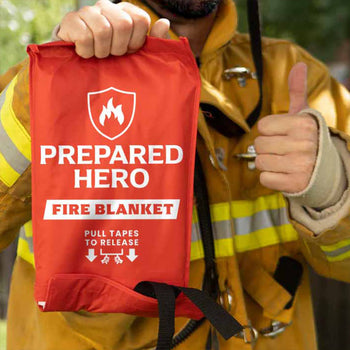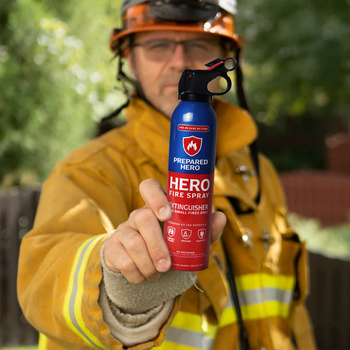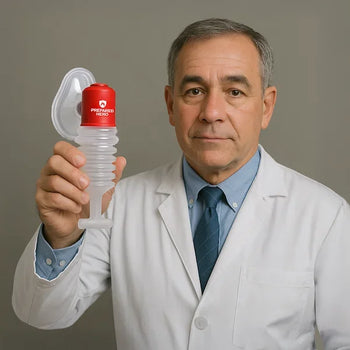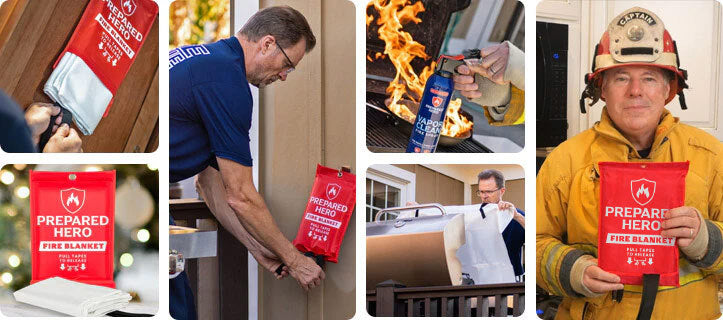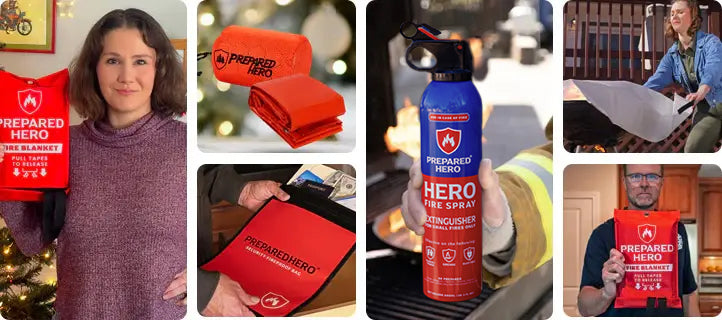Where you put your smoke detectors matters just as much as installing them. Proper placement makes sure they can detect...
When used by a trained person, a fire extinguisher keeps your family safe by preventing a fire in your home. But what type of fire extinguisher should you choose?
When choosing a fire extinguisher, you must first know how each type functions. In this post, we’ll talk about fire extinguisher types, how they work, and how to choose the right one depending on the type of fire you’re dealing with.
Fire Extinguisher Types
The six fire extinguisher types are water, mist, wet chemical, powder, foam, and carbon dioxide.
Each fire extinguisher can put out different fire classes, so you must choose the one that fits your needs.
Here’s a chart summarizing the different types of fire extinguishers and the fire classes they put out:
| Water | Water Mist | Wet Chemical | Powder | Foam | Carbon Dioxide | |
| Class A | ✅ | ✅ | ✅ | ✅ | ✅ | ❌ |
| Class B | ❌ | ✅ | ❌ | ✅ | ✅ | ✅ |
| Class C | ❌ | ✅ | ❌ | ✅ | ❌ | ❌ |
| Class D | ❌ | ❌ | ❌ | ✅ | ❌ | ❌ |
| Class F | ❌ | ❌ | ✅ | ❌ | ❌ | ❌ |
| Electrical | ❌ | ✅ | ❌ | ✅ | ❌ | ✅ |
Water Fire Extinguisher

Water fire extinguishers have bright red labels. They’re primarily used for places with class A fire risk. In particular, you can use water fire extinguishers to put out fires involving solid combustibles like paper, wood, fabric, and cardboard.
It should not be used to put out kitchen fires, those caused by flammable liquids and gas, and most electrical fires.
However, a few water fire extinguisher models can only be used on electrical fires if they pass dielectric tests. Otherwise, they shouldn’t be used to put out electrical fires.
How Does a Water Fire Extinguisher Work?
A water fire extinguisher works by cooling the fuel (burning combustibles). By doing this, this type of fire extinguisher causes the fire to burn at a slower rate until the flames are entirely gone.
In particular, a water fire extinguisher expels water to extinguish the fire. When you remove the tamper seal, pull the safety pin out, and squeeze the lever, the pointed rod punctures a canister containing high-pressure gas.
The gas gets released into the cylindrical tank, pushing the water downward. Next, the pressure from the gas pushes the water out of the fire extinguisher with enough strength to extinguish the fire from a safe distance of four to six feet.
Water Mist Fire Extinguisher

Source: UltraFire
Water mist fire extinguishers have white labels. They work against class A, B, C, and electrical fire.
Some water mist extinguishers can also put out fires caused by electrical equipment with up to 1,000 volts (e.g., printers and computers).
Like water fire extinguishers, they don’t contain any chemicals. Water mist fire extinguishers also don’t leave residue and collateral damage. You can also recycle them.
How Does a Water Mist Fire Extinguisher Work?
A water mist fire extinguisher cools the fire and decreases the oxygen supply. By doing these, they eventually extinguish the fire.
Additionally, water mist extinguishers use deionized water, a non-conductive and non-toxic substance.
In particular, a water mist fire extinguisher expels water through its special nozzle. The nozzle then releases microscopic water particles that form a mist curtain.
The water particles then cool down the air. It also fills it enough to reduce the oxygen feeding the fire. As a result, the water particles suffocate the fire.
Since the droplets are so tiny, they leave nearly no trace, making water mist extinguishers safe for electronics, books, fabric, and the like.
Wet Chemical Fire Extinguisher

Source: UltraFire
Wet chemical fire extinguishers have yellow labels. They’re primarily used for places with class F fire risk. You can also use them if your house is at risk of a class A fire (caused by wood, textile, cardboard, and paper). However, water or foam extinguishers are more commonly used.
In addition, many people use them to put out kitchen fires because they can quickly eliminate burning cooking oil and fat.
How Does a Wet Chemical Fire Extinguisher Work?
Wet chemical fire extinguishers contain potassium, which decreases the fire’s temperature and stops it from spreading.
In particular, a wet chemical extinguisher sprays potassium out through its special lance nozzle. Next, the fine mist reacts with the fats and oils in the fire. It then produces a soapy layer that cools, suffocates, and eventually puts out the fire.
Powder Fire Extinguisher

Powder fire extinguishers have blue labels. They’re one of the most versatile fire extinguisher types.
Powder extinguishers can be used on class A, B, C, and electrical fires. In addition, they’re suitable for places with mixed fire risks. However, when used in enclosed spaces, people might inhale the powder, which puts them at risk.
Hence, you shouldn’t use powder fire extinguishers for tiny rooms, houses, and offices. However, places with engine rooms and outdoor machinery should have them in stock.
How Does a Powder Fire Extinguisher Work?
A powder fire extinguisher expels fine powder made of sodium bicarbonate (baking soda), potassium bicarbonate (nearly identical to baking soda), or monoammonium phosphate.
These chemicals extinguish a fire by spreading and melting over the flames. The powder coats the fuel, which separates it from the oxygen in the air. As a result, the fire dies down.
Moreover, the dry powder protects objects against radiated heat, preventing fires from reigniting.
Foam Fire Extinguisher

Foam fire extinguishers have cream labels. They work on class A and B fires. Just like dry chemical extinguishers, foam extinguishers also prevent fire from reigniting. If dielectrically tested, they can be used against electrical fires.
However, you must not use this fire extinguisher for fires caused by flammable metals. You should not use it to put out kitchen fires, either.
Foam extinguishers are commonly found in warehouses, homes, hospitals, schools, offices, and buildings with flammable liquids.
How Does a Foam Fire Extinguisher Work?
A foam fire extinguisher works by cooling down the fuel responsible for the fire.
The foaming agent creates a barrier between the fuel and the flame when aimed at a vertical surface near the fire. As the foam builds up on the surface of the fire, it cuts off the oxygen supply and cools the fuel. Eventually, the fire dies down.
Carbon Dioxide Fire Extinguisher

Carbon dioxide fire extinguishers have black labels. Initially designed to put out class B fires, you can use a CO2 extinguisher against electrical fires.
Since carbon dioxide fire extinguishers don’t leave residue behind, they’re ideal for putting out fires caused by electrical equipment. Given this, CO2 fire extinguishers are present in computer server rooms, laboratories, and medical rooms.
How Does a Carbon Dioxide Fire Extinguisher Work?
As its name implies, this fire extinguisher uses carbon dioxide to put out fires.
In particular, the carbon dioxide displaces the oxygen that fuels the fire. By doing this, the CO2 fire extinguisher takes away the oxygen supply, leaving the fire to die down eventually.
The carbon dioxide from the fire extinguisher is also extremely cold, so it also cools the fuel.
Frequently Asked Questions
What are the 4 types of fire extinguishers?
The 4 types of fire extinguishers are wet (water, water mist, wet chemical), dry (powder), foam, and carbon dioxide. Depending on the type used, these four types of fire extinguishers can put out class A, B, C, D, F, and electrical fires.
What are the 5 types of fire extinguishers used for?
The 5 types of fire extinguishers are used for putting out class A, B, C, D, F, and electrical fires. Water fire extinguishers put out class A fires, while foam extinguishers put out class A and B fires.
On the other hand, powder fire extinguishers put out class A, B, C, and electrical fires. Carbon dioxide extinguishers fight class B and electrical fires, while wet chemical extinguishers eliminate class A and F fires.
What are the 3 types of fire extinguishers?
The 3 types of fire extinguishers are carbon dioxide (CO2), dry chemical (powder), and air-pressurized (water mist). Wet chemical, water, and foam fire extinguishers are also used often.
What are the 5 different classes of fire?
The 5 different classes of fire are:
- Class A (solid materials)
- Class B (flammable liquids)
- Class C (combustible gases)
- Class D (flammable metals)
- Class F (cooking oil or grease)
Hero Fire Spray

While fire extinguishers help a lot, they can be expensive, heavy, and hard to store. The residue from the fire extinguisher may also be hard to clean up.
Use a fire spray if you want a more affordable, lightweight, and convenient way to put out a fire in seconds.
Prepared Hero’s fire spray is an easy-to-use alternative to fire extinguishers.
Hero Fire Spray will help you deal with minor fire accidents and stop them before they turn into bigger disasters.
Plus, Prepared Hero’s fire spray is biodegradable and non-toxic. Unlike a fire extinguisher, you can safely use it around your family and pets. It's also eco-friendly, so you’re taking part in saving the environment.
Lastly, Prepared Hero’s fire spray is made in the US, so we guarantee its quality and can arrive at your doorstep fast.
Here’s a table summarizing the differences between Prepared Hero’s fire spray and a regular fire extinguisher:
| Prepared Hero’s Fire Spray | Regular Fire Extinguisher |
| Lightweight, easy to carry | Heavy, hard to carry |
| Easy to store | Needs more space for storage |
| 100% biodegradable | Mostly made of non-biodegradable materials |
| Non-toxic | Toxic |
| Easy to clean | Hard to clean |
| Safe for kids and pets | Not safe for kids and pets |
Conclusion
You can prevent house fires by putting them out while they’re small. To do that, you need a fire extinguisher.
Fire extinguisher types work differently, so you must know which one you must have at home. For ordinary fires at home, water, water mist, wet chemical, powder, and foam fire extinguishers work. But if you want one specifically for kitchen fires, you should have a wet chemical fire extinguisher.
In addition, while it’s impossible to foresee where or when a fire will start, you can take steps to get ready if it does.
Assembling a fire kit with an emergency fire blanket, fire spray, and a smoke mask helps. Go to Prepared Hero and shop for fire safety tools now!


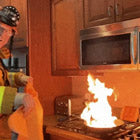 Fire
Fire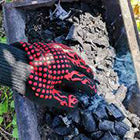 Safety
Safety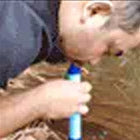 Survival
Survival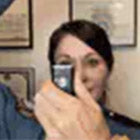 Protection
Protection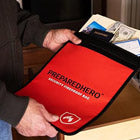 New
New
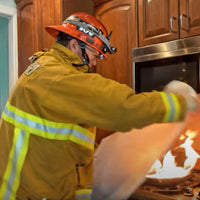 Fire
Fire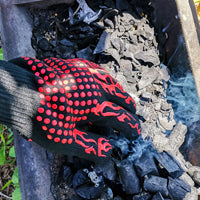 Safety
Safety Survival
Survival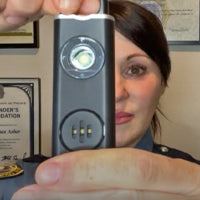 Protection
Protection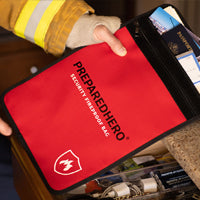 New
New
